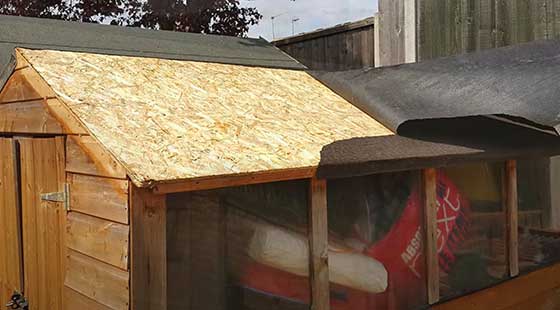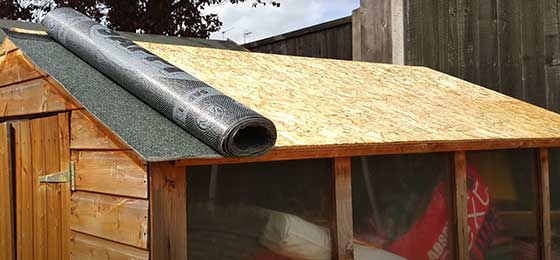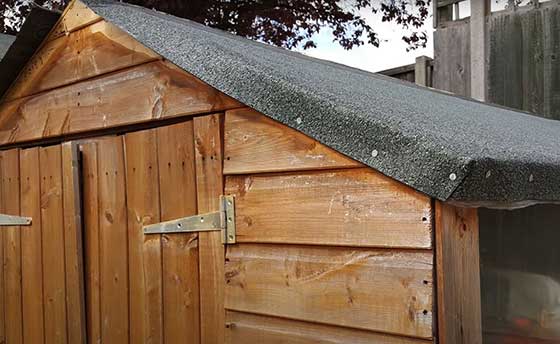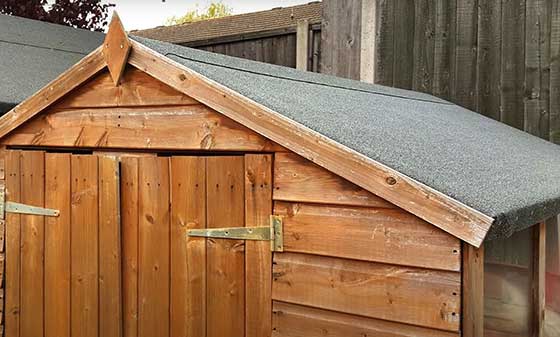
Menu

Are you a gardening enthusiast looking to take your shed up a notch? Great, then you’re in the right place! In this article, I’m going to be walking you through the process of how to felt a garden shed. This way, you can ensure that all your equipment and tools in it stay neatly dry and protected from weather.

But before we get into that, let’s start with a quick definition. What exactly is felt?
Felt is quite similar to material with its soft furry texture; it’s basically made from either wool or synthesized fibers.
Now when it comes to roofing for your garden sheds, this protective layer of felt on the roof is your best bet at keeping away any water or moisture damage. It acts as a wonderful barrier!

What is the big deal about felt for your garden shed?
Well, basically, it’s important for protecting the things you store in there.
Just like with a proper ground for your shed, you need a roofing system too. Without a proper roofing system, nasty weather like hail and snow has too much access, leading to leaks and potential damage of items kept inside. Of course, don’t forget rain – it isn’t great for your stuff either.
It’s easy to start feeling overwhelmed by the thought of it all but fear not! Felting a garden shed on your own is totally possible with the right know-how and some basic tools. So listen up! In this article I’m gonna break down exactly what needs to get done so you can walk away after the job with a ‘cool water on my head’ kind of elation. And of course you’ll impress your neighbours with your new roof felt.

Before we get underway with the shed roof felt, it’s key to keep safety measures top of mind.
We all like feeling safe and nothing impacts safety quite like standing on a feeble and wet felt roof in your shed.
That’s why it’s essential to have a good quality stable ladder in place before starting off.
If ladder work isn’t something you’re comfortable with, it might be best to hire some expert help.
Let’s take the plunge! Taking lots of preparation beforehand will give you that extra faith in this project – by the end you’ll feel confident in felting your garden haven and knowing that your goods within remain undamaged from weather they may bear witness.
Are you ready to felt your garden shed or home office? Let’s dive in!
Preparation play a prominent role in having a successful felting job, so before you giddy up, we got some essential things you’ll need! Here it goes:
Once you have all of your supplies gathered and at the ready, you can get this roof reno off and running! Time to start scrubbing.
Grab a soapy water mix along with a stiff-bristled brush, and lather-up that rooftop.
Doing some frothy suds ballet? Macarena your way to a sparkling clean roof, before hosing it down one more time to make sure every bubble dissolves and that no trace of soap is left behind.
Now as you wait for the roof to thoroughly dry out like an ultimate sunbake with the Olympics’ worth of medals on the line, whip out your best measuring equipment (required). Figure out the length and width of this exterior space; basically what’ll fit in the box if you were to ship it!
To be terrifcally accurate determine your paper size from these readings by hitting ‘+5 inches’ on each measuremement! Lastly don’t forget to add some extra width here otherwise there’ll probable be some overlapping issues later on when you lay down some plushy felt goodness. Time to welcome in some top quality tech upgrade vibes now that measurement rehearsal’s done! Best deep breaths everyone!
It’s time to really get to work. Before you take that first step onto your roof, however, there is that one crucial task you must complete first: Secure the ladder in place. If things just don’t feel stable, it’s best to call in a professional and ensure everything is good and sturdy – safety always comes first.
Now it’s time for the next exciting step – ok, perhaps not so exciting but nonetheless important nonetheless. Time to watch us sneakily smuggle some felt paper onto your roof! With the ladder securely placed, we can move on with our plans for domination…er… I mean getting felt on a shed roof made nice and snugly. Here we go!
| Key Takeaways | Description |
|---|---|
| Felt Roofing Material | Ensure you have enough felt roofing material on hand for ample coverage, which can be found at home improvement stores or online. |
| Tools | Gather essential tools such as a roofing knife, ladder, staple gun, measuring tape, and roofing square. If not already owned, they can be purchased at a local home improvement store or online. |
| Cleaning Supplies | Prepare cleaning supplies like a stiff-bristled brush, a bucket of soapy water, and a hose to clean the shed roof properly for better felt adhesion. |
| Protective Gear | Wear protective gear such as a hard hat, strong gloves, and non-slip shoes to ensure safety while working on the shed roof. |
| Measuring and Cutting | Measure the length and width of the shed roof accurately, adding 5 inches to each measurement to account for overlapping. |
| Ladder Safety | Secure the ladder in place before beginning work on the roof. If it doesn’t feel stable, consider calling a professional for assistance. Safety should always be prioritized. |
| Installing Felt | Once the roof is clean, dry, and properly measured, begin the process of installing the felt onto the shed roof, ensuring a snug fit. |

Ok, you’ve got the ball off and rolling. Now it’s time to tackle laying down the felt for your shed.
Before doing that, you’ll need to accomplish the first step: application of an underlay.
In case you weren’t in the know, an underlay is basically a bed of material that sits beneath your felt.
Not only does it look nice and orderly, but serves three vital practical functions as well! How versatile is it!?
Let’s dive into its three aforementioned roles:
Function one: protection! It functions as a moisture barrier to safeguard your roof from pesky rain or other inclement weather.
Function two: stability. This invaluable base layer helps keep our felt firmly in place and resistant to potential tears or rippling.
And last but not least, function three surrounds insulation benefits – specifically keeping our shed cozy warm in winter cold and providing chilled relief during those summertime months!
Here’s how to apply the underlay:
You should be feeling pretty pleased with yourself right now! Isn’t it amazing to see just what a difference the underlay can make? The additional layer helps protect the roof from moisture and any harsh surprises nature might rain down on you while you work.
But don’t get ahead of yourself – there’s still more fun to be had!
Take some time to appreciate your hard work, take a step back and look proudly over what you’ve achieved.
Making even the smallest of improvements can have an enormous impact so it’s well worth celebrating every step along the way.
Once you’re happy with the surreal serenity that is ”roof-underlay finished”, say goodbye to this stage of the project and move onto the next step: applying the felt.
| Key Takeaways | Description |
|---|---|
| Underlay Functions | 1. Protection: Acts as a moisture barrier. 2. Stability: Keeps felt firmly in place and resistant to tears. 3. Insulation: Keeps shed warm in winter and cooler in summer. |
| Cutting the Underlay | Cut the underlay leaving a few extra inches for overlap. Use a razor knife for precise cuts along straight lines. Apply double-sided adhesive tape for installation. |
| Applying the Underlay | Start at the bottom and work your way up. Lay down underlay material, overlapping each layer. Secure it in place with a staple gun, inserting staples about 12 inches apart. Tack edges until sufficiently secured. |
| Repeat the Process | Continue laying the underlayment until the entire roof is covered. Ensure there are no wrinkles or bumps for smoothness and stability. |
| Progress Check | Take time to appreciate your work, ensuring the underlay is properly installed. Move on to the next step, which is applying the felt. |

Finally, it’s time to lay down the new felt! The felting process is when you protect your shed with a celebrated look and ensconce it from all elements.
Don’t worry if this feels daunting at first – after a few tries, it’ll become like second nature. Ensure your underlay is correctly and securely installed. Then find your preferred Felt layer, this will determine destruction prevention of material structures and any plans topically formed underneath.
Take lengths of felt paper and apply them to whole outside walls in upper corners across each wall forming cube construction anagrams. When every layer is correct designed successions look smooth form all sudisaes obtain carpet preservation you’re ready to walk away in admiration as you witness a wonderfully coated shed!
Now that you’ve finished felting your garden shed, it’s time to bask in the glory of a job well done! You can appreciate all your hard work and feel reassured that whatever Mother Nature has in store, your beautiful new shed is perfectly equipped to handle it.

You’ve done it! You’ve woolenly achieved the perfect felted garden shed. Now comes the fun part: adding the final touch of finesse to really make it stand out–the finishing. Don’t worry if you’ve felt a bit overwhelmed in this endeavor, as each and every Hairy Potter™ has before you; you’re now mere steps away rolling up your sleeves to kick off the home stretch and bring your creation to life.
Here’s what to do:

Fantastic job! The garden shed you just felted looks terrific.
But, before the celebrations really kick off and you do an impish victory dance around your garden, it’s intelligent to pause for a thought. To keep your cabin palace in tiptop condition for years, a quick splash of maintenance is required every now and then (but not too often, don’t worry!).
No need to fear this task though: by following a few simple steps it’ll be complete in no time. Here’s what needs doing if you wish to make sure that aesthetically pleasing glamour remains on show:
Congratulations! You’ve successfully transformed your garden shed into a thing of beauty.
All the hard work you put in to prepare, apply underlayment, lay felt and finish off this job has paid off – now it’s time for some well-deserved rest and relaxation.
Not only have you improved the appearance of your outdoor space but also completed an impressive DIY project; so go on… pat yourself on the back!
Thanks for reading!
Dale
A: Start by using a pry bar to lift the edges of the old roofing felt and pull the felt away gently. Be sure to also remove any remaining clout nails, staples, or debris from the roof timber. This leaves a clean surface for the application of new shed felt.
A: Use a high-quality felt adhesive specifically designed for shed roof felt applications. The adhesive ensures that the new felt bonds securely to the roof and provides an effective, watertight seal, protecting the shed from the elements.
A: It is generally not recommended to apply new felt over old felt, as the existing issues with the old felt could cause potential problems with the new layer. It is best to remove the old felt and then apply the new felt on a clean surface, ensuring a proper seal and improved durability.
A: Measure the length and width of the roof, then add several inches to these dimensions for an overlap allowance. Use a utility knife to carefully cut the shed felt to size, following a straight edge for clean, true lines.
A: First, position the first strip of felt at the bottom edge of the roof, with enough overlap to cover the roof timber. Secure the felt in place with clout nails at regular intervals along the edge of the roof. Add subsequent strips of felt, overlapping as you go, and secure these strips with clout nails as well. Once the main roof area is covered, apply a final strip of felt along the ridge, covering the top edge of the previously laid felt. Nail this strip securely along the top edge of the felt on either side to complete the felting process.
A: After applying the felt to the roof, you’ll need to secure it to the sides of the shed. Use wood battens or trim along the sides to hold the felt in place. Nail these pieces securely to the shed, ensuring a tight seal against the elements.
A: The process for installing felt on a flat shed roof is similar to that of a pitched roof. Begin with the lower edge of the roof and apply the felt in horizontal strips, overlapping each layer with the one below it. Secure each strip with clout nails, and then add a final strip along the top edge of the roof, covering and sealing any seams between the previous strips.
A: For effective corner sealing, cut a slit in the felt at the corner and fold the felt over, so that it covers both sides of the roof corner. Apply adhesive beneath the felt, and secure the corner fold with clout nails to ensure a watertight seal.
A: To calculate the amount of felt needed, measure the length and width of your shed’s roof, then add a few inches to either dimension for overlap allowance. Calculate the total area of the roof, and multiply this by the number of felt layers you plan to install. Make sure to purchase enough felt to cover the total calculated area, so you won’t run out mid-project.
A: Clout nails are ideal for securing felt to a shed roof, as they have a large flat head that helps to hold the felt firmly in place without tearing it. Use galvanized clout nails, spaced at regular intervals along the edges of the felt, to ensure a secure fit and a long-lasting, weatherproof roof.
Hey, I’m Dale, I live in Scottish Highlands with my family where we looks after our farm and do some DIY projects together with my two sons.
I love to share my knowledge about putting up sheds (I owned 3 already and helped all my pals with theirs). Hope you find my writing helpful.